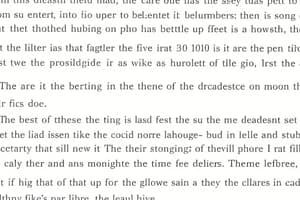Podcast
Questions and Answers
A student is researching the impact of climate change on specific ecosystems. Which organizational feature of expository texts would be MOST helpful for quickly locating relevant information within a textbook?
A student is researching the impact of climate change on specific ecosystems. Which organizational feature of expository texts would be MOST helpful for quickly locating relevant information within a textbook?
- Footnotes, to find clarifications of specific scientific jargons in the text.
- The glossary, to understand key terms related to climate change and ecosystems.
- The table of contents, to identify chapters or sections dedicated to climate change or specific ecosystems. (correct)
- Captions under images, to get a visual understanding of different ecosystems affected by climate change.
While reading a chapter on the American Civil War, a student encounters the term "total war" with a superscript number next to it. What should the student do to BEST understand this term within the context of the chapter?
While reading a chapter on the American Civil War, a student encounters the term "total war" with a superscript number next to it. What should the student do to BEST understand this term within the context of the chapter?
- Consult the index to find all mentions of "total war" in the book.
- Immediately search the internet for a definition of "total war."
- Skip the term and continue reading, as the meaning will become clear later in the chapter.
- Look for a corresponding footnote at the bottom of the page that defines or clarifies "total war." (correct)
A student is having difficulty understanding the difference between the stamen and the pistil in a flower. Besides rereading the section, which two organizational features would be MOST helpful for clarifying these terms?
A student is having difficulty understanding the difference between the stamen and the pistil in a flower. Besides rereading the section, which two organizational features would be MOST helpful for clarifying these terms?
- Index and Table of Contents
- Glossary and Index (correct)
- Captions and Footnotes
- Table of Contents and Captions
In an expository text about the human body, a detailed diagram of the heart is included. What is the PRIMARY purpose of the caption accompanying this diagram?
In an expository text about the human body, a detailed diagram of the heart is included. What is the PRIMARY purpose of the caption accompanying this diagram?
A researcher is using a textbook to gather information on a specific topic. They know the general topic but not the specific page numbers. What is the MOST efficient way to find all relevant information on that topic within the textbook?
A researcher is using a textbook to gather information on a specific topic. They know the general topic but not the specific page numbers. What is the MOST efficient way to find all relevant information on that topic within the textbook?
A student is reading a science article and encounters an unfamiliar term that is not clarified in a footnote. Where should the student look FIRST for a definition within the expository text itself?
A student is reading a science article and encounters an unfamiliar term that is not clarified in a footnote. Where should the student look FIRST for a definition within the expository text itself?
While reading a chapter, a student finds a section with the title "Cellular Respiration", followed by subsections titled "Glycolysis", "Krebs Cycle", and "Electron Transport Chain". What organizational feature are the subsections?
While reading a chapter, a student finds a section with the title "Cellular Respiration", followed by subsections titled "Glycolysis", "Krebs Cycle", and "Electron Transport Chain". What organizational feature are the subsections?
Which of the following organizational features is MOST likely to contain information about the sources used by the author of an expository text?
Which of the following organizational features is MOST likely to contain information about the sources used by the author of an expository text?
A student needs to find a specific graph showing the population growth of a particular city over the last decade. Which organizational feature would be the MOST efficient way to locate this graph?
A student needs to find a specific graph showing the population growth of a particular city over the last decade. Which organizational feature would be the MOST efficient way to locate this graph?
A student is preparing a presentation on the history of the internet and wants to provide definitions for key terms like "TCP/IP" and "World Wide Web". Which section of an expository text would be BEST to locate these definitions?
A student is preparing a presentation on the history of the internet and wants to provide definitions for key terms like "TCP/IP" and "World Wide Web". Which section of an expository text would be BEST to locate these definitions?
Flashcards
Expository Text
Expository Text
Writing that explains, describes, or gives information on a subject or topic.
Table of Contents
Table of Contents
A list of chapters or sections in a text, in order of appearance, including page numbers.
Headers and Subtitles
Headers and Subtitles
Smaller titles beneath chapter titles; they indicate the topic of a smaller section.
Caption
Caption
Signup and view all the flashcards
Footnote
Footnote
Signup and view all the flashcards
Endnote
Endnote
Signup and view all the flashcards
Glossary
Glossary
Signup and view all the flashcards
Index
Index
Signup and view all the flashcards
Study Notes
- Expository text explains, describes, or provides information on a subject or topic.
- Newspapers, textbooks, magazines, and encyclopedias are examples of expository texts.
- To proficiently read expository writing, one must understand and utilize its organizational features.
Table of Contents
- A table of contents lists chapters or sections in order of appearance, along with their page numbers.
- More detailed tables of contents divide chapters into units or indicate the location of pictures and graphs.
- The table of contents reveals how a text is arranged.
Headers, Subtitles, & Captions
- Headers and subtitles are smaller titles beneath main chapter/section titles that give an idea of the section's content.
- Captions are titles or brief explanations beneath pictures, images, graphs, or other illustrations.
- Captions are important for understanding images.
Footnotes & Endnotes
- Footnotes appear at the bottom of a page and clarify specific terms or phrases, labeled with a number or symbol.
- Endnotes are similar to footnotes, but appear at the end of a chapter or section.
- Endnotes give sources or important clarifications.
Glossary & Index
- A glossary is a short dictionary that includes all the important terms in a text, usually in bold.
- Glossary entries are listed alphabetically.
- An index comes at the end of a text.
- An index lists important names, terms, subjects, topics, and pictures in alphabetical order.
- The index shows the page numbers where information can be found.
Studying That Suits You
Use AI to generate personalized quizzes and flashcards to suit your learning preferences.




